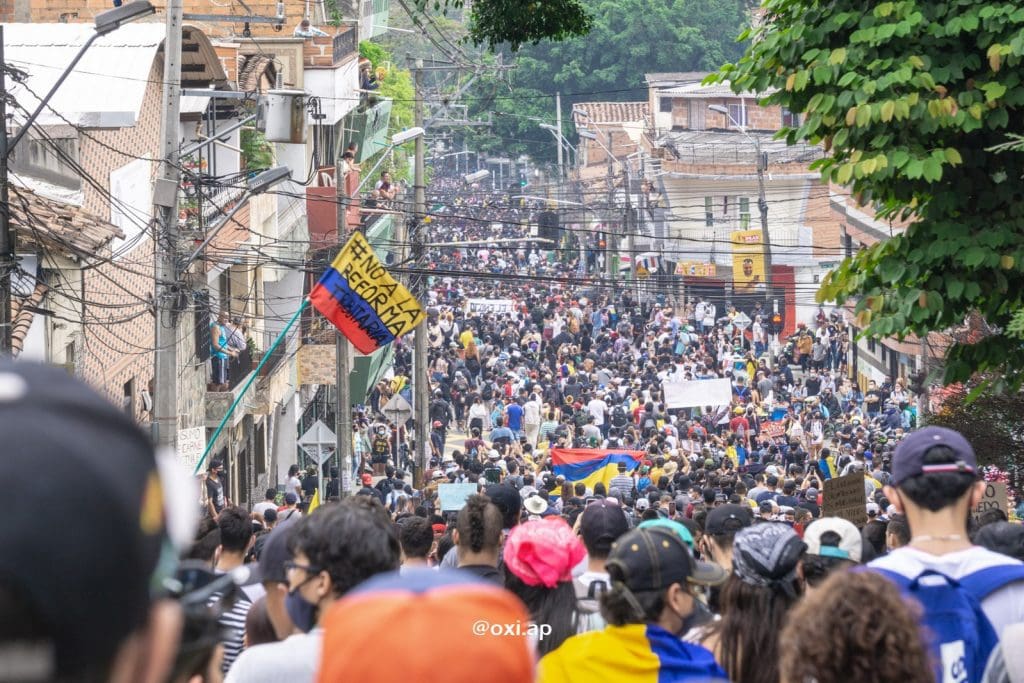Wooden spoons clanking against metal casseroles. Drums and voices singing Bullerengue among protestors in the streets. Rappers denouncing state violence on social media. Vogue artists dancing in front of heavily armed riot control units. Tanks and projectiles firing into a multitude of voices chanting in unison: Resistance, resistance. For a few months during 2021, the Colombia National Strike of 2021 took on an unstoppable force, invigorated by the music that is so inextricable from the country’s culture. In the face of violence and injustice, artists took to the streets and took their art with them: to heal, to unite, to resist, to denounce.
The 2021 Colombia National Strike erupted on April 28, following the proposition for a new tax reform bill - protest that continued and blossomed into a widespread mobilization against Ivan Duque’s government, state violence, poverty, corruption, and inequality. These protests saw the deaths of 80 civilian victims in the hands of police, more than 800 disappeared protesters and countless human rights violations, especially against students and young people. The strike achieved the destitution of the finance minister Alberto Carrasquilla as well as the withdrawal of the tax reform bill, but similar to strikes in previous years there was no real response to historic claims of continued state violence. Colombian artists were able to show these claims to the world through music - using art as a medium to unite the people and convey a stronger message. The protests saw the rise of many new artists across genres that released songs denouncing inequality and state violence. These artists, many coming from the most marginalized and violence-ridden places of Colombia, were able to use art to convey complex collective feelings, ranging from unconformity and anger to sadness and despair, to hope and unity.
Jhon Jota - Resistencia
This is the case of John Jota, a 20 year old rapper from the indigenous Nasa community of the Cauca department of Colombia who says “I walk the word and the word is resistance / my only armor is art”. His song Resistance talks about the violent realities of his territory and encourages protesters in Cali, Cauca’s capital, sending a message to the president that “the people stand their ground”.
Other Colombian hip hop artists such as the young Hendrix Hinestroza used their influence and the strength of social media to denounce social injustice through hip hop, showing how digital tools can be an effective way of modern protest.
Mobilizations were also often accompanied by bullerengue bands, a musical genre of the Colombian Caribbean characterized by African drums and female-led singing that invites question response type choirs from the crowds. Using the sounds of bullerengue, these bands invited protesters to join in singing and dancing, creating outlets for collective grief as well as collective healing with this traditional music. New songs were released from these bullerengue spaces, for example the song Guayabo from the band La Perla, an all-female band who was seen often playing and marching alongside protesters in Bogotá.
La Perla - Guayabo
The song is a scathing description of Colombian state violence and people’s fight for peace, directly addressing the government, and referencing the strike’s slogans in its lyrics like “They have stolen so much from us that we have even lost our fear” as well as incorporating elements of the mobilization soundscape, like the noises of people hitting empty pans and casseroles as a form of protest.
Other artists were also inspired by the events and chants from the mobilizations, like Edson Velandia and Adriana Lizcano, who released two satirical music videos during the national strikes addressing many right-wing perceptions of protesters as lazy people who want everything for free or as infiltrated by armed groups. The former single, Todo Regalao turns that narrative around by saying that the ruling class wants everything for free, denouncing tax exemptions, misuse of public funds and corruption with lyrics such as “The pearls of the queen; we pay for them/ The lazy senator’s salary; we pay for it/ Why is it that rich people want everything for free?”.
Edson Velandia & Adriana Lizcano - Todo Regalao
The latter El infiltrado re-interprets a popular anti-police protest chant where large crowds of people jump together while repeatedly singing “El que no salte es tombo” / “If you don’t jump you’re a cop”. Using the same base rhythm of the chant, Velandia and Lizcano jump while singing “If you don’t jump you are the infiltrate / Everyone knows who infiltrates the marches / The indigenous people know it, the LGBTQ people know it / The students know it, the truckers know it / If you don’t jump you are the infiltrate”. The songs’ lyrics imply that the infiltrator might be the policemen. The song also celebrates the taking down of colonial monuments during the protests and directly addresses the president and government as criminals.
Edson Velandia - El infiltrado
Other already-known national artists actively participated in the National Strike with musical performances to fight civilian indifference. An example was a surprise a capella performance in the Medellin metro, sung by La Muchacha, Briela Ojeda and Lianna. Letting their voices pierce the quiet train, the artists sang “Aquí la gente para, el estado dispara”/ “Here when people strike, the state shoots”.
Lianna, Briela Ojeda y La Muchacha - Aquí la gente para, el Estado dispara, la canción sobre el Paro Nacional
The role of national orchestras and musical groups doing public performances was also significant during the National Strike, with musicians presenting alternative or creative forms of protest to ask for peace and bring public attention to the issue.
Les dejo el video del minuto de silencio de hoy. Gracias a mis queridos músicos. ♥️♥️♥️ (Y gracias Twitter por acogerme en tus brazos) pic.twitter.com/VomqIaNntJ
— Susana Boreal (@SusanaBoreal) May 6, 2021
Finally, internationally well known Colombian artists such as Shakira, Kali Uchis, Aterciopelados, Lido Pimienta and the band Chocquibtown released statements in support of the Colombian people and against violence, using their fame to bring visibility to the situation in Colombia. Notably, artists that did not use their international platforms to show their support or were perceived to remain impartial, like reggaeton singer J Balvin, faced enormous backlash and lost followers.
The chants used during the national strike also became key musical elements that shaped people’s motivations and demands. One of the strike’s anthems was a reinterpretation of the ubiquitous and world-known song Bella Ciao - but this time, adapted to ask for the destitution of the President, “Duque Chao” or “Bye Duque”. One of the adapted lyrics of this song directly states “If your government keeps killing, we won’t stop marching”.
Duque Chao
Other chants were adapted into the popular music and dance of protest hotspots, such as the musical genre Salsa Choque in Cali. This mix of salsa, reggaeton and afrobeat from the Pacific Coast was brought to Cali by afro-colombian populations forcibly displaced from Tumaco because of the internal conflict. Cali was one of the places that saw the most resistance and violence during the national strike, so incorporating chants into this lively beat that people could dance to became a source of unity.
1, 2, 3 Uribe Paraco
A crowd of people are shown dancing salsa choke and singing a chant that insults a right wing ex-president called Álvaro Uribe with the lyric “1, 2, 3 Uribe paramilitary”. Other forms of creative resistance through dance were seen through the actions of the LGBTQ community, a key group during the National Strike with a history of protesting against police violence.
A viral instagram video showed three masked dancers, Axid, Neni Nova and Piisciis, doing Voguing, a stylized modern house dance, in front of heavily armed members of the anti riot police, being cheered on by the crowd protesting in Bogotás central plaza.
This form of queer musical resistance and the bravery that it took to execute it in such a context of state repression was later explained by the lead dancer Piisciis, on their instagram: “In moments like these when we are being censored, art must continue to be the path the towards light and visibility that we need…When we raise our bodies and our voices, the world listens”. Since National Strikes with similar demands have been happening over the past 4 years, many chants and songs carry the meanings of previous strikes, reminding people of long-standing indignation. For instance, Ninio Sacro’s 2019 National Strike anthem Yo Marché was widely shared in 2021, as it compiles reasons why the people were striking in
2019 that were very similar to 2021.
Ninio Sacro -Yo Marché
However, some new anthems featuring key actors of the national strike came out in 2021, notably the Anthem of the Indigenous Guard, featuring the nation-wide Minga organization of indigenous peoples and the struggle “Por mi raza, por mi tierra / For my race, for my land”.
Parranderos del Cauca ft. Andrea Echeverry, Ali Aka Mind, Amós Piñeros, Chane Meza, La Perla, Carlos Arturo Villamarin, Derly Eliced Musse Pasu, Eulalia Yagari y Gregorio Merchan - Himno de la Guardia Indígena - Guardia Fuerza
Singing at the top of their lungs, unified in a common fight lulled by music and support songs and directed by artists, Colombians took to the streets for almost 4 months. Even though the National Strike finally ended and left many unconformities and pain for the people of Colombia, the musical legacy of the strike remains as a witness of the resistance of Colombian people against violence, and as an antidote for oblivion in the collective imaginary of the country.


